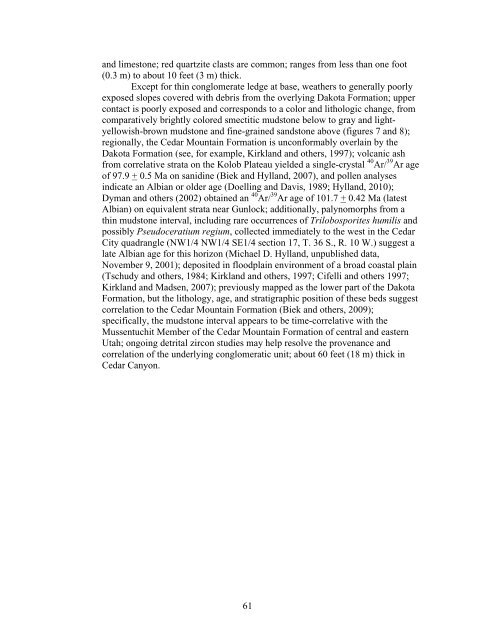Interim Geologic Map of the West Part of - Utah Geological Survey
Interim Geologic Map of the West Part of - Utah Geological Survey
Interim Geologic Map of the West Part of - Utah Geological Survey
Create successful ePaper yourself
Turn your PDF publications into a flip-book with our unique Google optimized e-Paper software.
and limestone; red quartzite clasts are common; ranges from less than one foot(0.3 m) to about 10 feet (3 m) thick.Except for thin conglomerate ledge at base, wea<strong>the</strong>rs to generally poorlyexposed slopes covered with debris from <strong>the</strong> overlying Dakota Formation; uppercontact is poorly exposed and corresponds to a color and lithologic change, fromcomparatively brightly colored smectitic mudstone below to gray and lightyellowish-brownmudstone and fine-grained sandstone above (figures 7 and 8);regionally, <strong>the</strong> Cedar Mountain Formation is unconformably overlain by <strong>the</strong>Dakota Formation (see, for example, Kirkland and o<strong>the</strong>rs, 1997); volcanic ashfrom correlative strata on <strong>the</strong> Kolob Plateau yielded a single-crystal 40 Ar/ 39 Ar age<strong>of</strong> 97.9 + 0.5 Ma on sanidine (Biek and Hylland, 2007), and pollen analysesindicate an Albian or older age (Doelling and Davis, 1989; Hylland, 2010);Dyman and o<strong>the</strong>rs (2002) obtained an 40 Ar/ 39 Ar age <strong>of</strong> 101.7 + 0.42 Ma (latestAlbian) on equivalent strata near Gunlock; additionally, palynomorphs from athin mudstone interval, including rare occurrences <strong>of</strong> Trilobosporites humilis andpossibly Pseudoceratium regium, collected immediately to <strong>the</strong> west in <strong>the</strong> CedarCity quadrangle (NW1/4 NW1/4 SE1/4 section 17, T. 36 S., R. 10 W.) suggest alate Albian age for this horizon (Michael D. Hylland, unpublished data,November 9, 2001); deposited in floodplain environment <strong>of</strong> a broad coastal plain(Tschudy and o<strong>the</strong>rs, 1984; Kirkland and o<strong>the</strong>rs, 1997; Cifelli and o<strong>the</strong>rs 1997;Kirkland and Madsen, 2007); previously mapped as <strong>the</strong> lower part <strong>of</strong> <strong>the</strong> DakotaFormation, but <strong>the</strong> lithology, age, and stratigraphic position <strong>of</strong> <strong>the</strong>se beds suggestcorrelation to <strong>the</strong> Cedar Mountain Formation (Biek and o<strong>the</strong>rs, 2009);specifically, <strong>the</strong> mudstone interval appears to be time-correlative with <strong>the</strong>Mussentuchit Member <strong>of</strong> <strong>the</strong> Cedar Mountain Formation <strong>of</strong> central and eastern<strong>Utah</strong>; ongoing detrital zircon studies may help resolve <strong>the</strong> provenance andcorrelation <strong>of</strong> <strong>the</strong> underlying conglomeratic unit; about 60 feet (18 m) thick inCedar Canyon.61
















